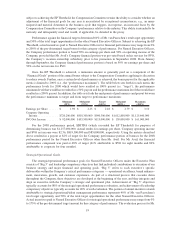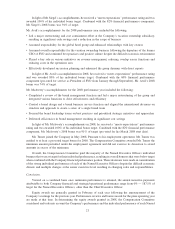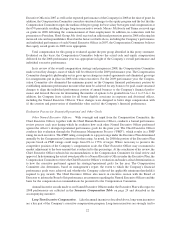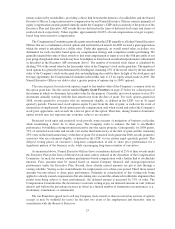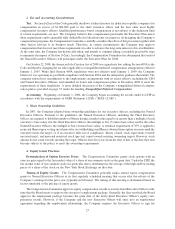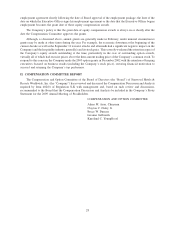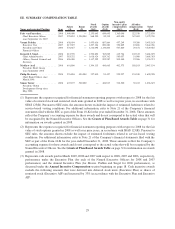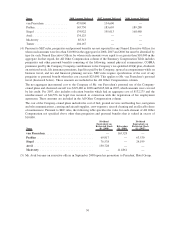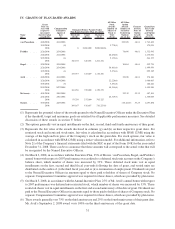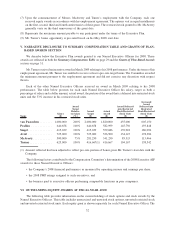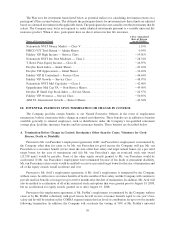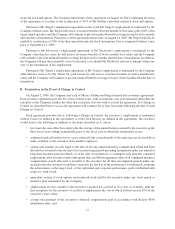Starwood 2008 Annual Report Download - page 39
Download and view the complete annual report
Please find page 39 of the 2008 Starwood annual report below. You can navigate through the pages in the report by either clicking on the pages listed below, or by using the keyword search tool below to find specific information within the annual report.2. Tax and Accounting Considerations
Tax. Section 162(m) of the Code generally disallows a federal income tax deduction to public companies for
compensation in excess of $1,000,000 paid to the chief executive officer and the four other most highly
compensated executive officers. Qualified performance-based compensation is not subject to the deduction limit
if certain requirements are met. The Company believes that compensation paid under the Executive Plan meets
these requirements and is generally fully deductible for federal income tax purposes. In designing the Company’s
compensation programs, the Compensation Committee carefully considers the effect of this provision together with
other factors relevant to its business needs. Therefore, in certain circumstances the Company may approve
compensation that does not meet these requirements in order to advance the long-term interests of its stockholders.
At the same time, the Company has historically taken, and intends to continue taking, reasonably practicable steps
to minimize the impact of Section 162(m). Accordingly, the Compensation Committee has determined that each of
the Named Executive Officers will participate under the Executive Plan for 2008.
On October 22, 2004, the American Jobs Creation Act of 2004 was signed into law, adding Section 409A to the
Code and thereby changing the tax rules applicable to nonqualified deferred compensation arrangements effective
January 1, 2005. While final Section 409A regulations were not effective until January 1, 2009, the Company
believes it was operating in good faith compliance with Section 409A and the interpretive guidance thereunder. The
company entered into amendments to the employments arrangements with its senior officers, including the CEO
and Named Executive Officers, and amended its bonus and compensation plans in December 2008 to meet the
requirements of these regulations. A more detailed discussion of the Company’s nonqualified deferred compen-
sation plan is provided on page 35 under the heading Nonqualified Deferred Compensation.
Accounting. Beginning on January 1, 2006, the Company began accounting for awards under its LTIP in
accordance with the requirements of FASB Statement 123(R) (“SFAS 123(R)”).
3. Share Ownership Guidelines
In 2007, the Company adopted share ownership guidelines for our executive officers, including the Named
Executive Officers. Pursuant to the guidelines, the Named Executive Officers, including the Chief Executive
Officer, are required to hold that number of Shares having a market value equal to or greater than a multiple of each
executive’s base salary. For the Chief Executive Officer, the multiple is five (5) times base salary and for the other
Named Executive Officers, the multiple is four (4) times base salary. A retention requirement of 35% is applied to
restricted Shares upon vesting (net shares after tax withholding) and Shares obtained from option exercises until the
executive meets the target, or if an executive falls out of compliance. Shares owned, stock equivalents (vested/
unvested units), and unvested restricted stock (pre-tax) count towards meeting ownership targets. However, stock
options do not count towards meeting the target. Officers have five years from the date of hire or the date they first
become subject to the policy to meet the ownership requirements.
4. Equity Grant Practices
Determination of Option Exercise Prices. The Compensation Committee grants stock options with an
exercise price equal to the fair market value of a share of our common stock on the grant date. Under the LTIP, the
fair market value of our common stock on a particular date is determined as the average of the high and low trading
prices of a share of the stock on the New York Stock Exchange on that date.
Timing of Equity Grants. The Compensation Committee generally makes annual equity compensation
grants to Named Executive Officers at its first regularly scheduled meeting that occurs after the release of the
Company’s earnings for the prior year (typically in February). The timing of this meeting is determined based on
factors unrelated to the pricing of equity grants.
The Compensation Committee approves equity compensation awards to a newly hired Executive Officer at the
time that the Board meets to approve the executive’s employment package. Generally, the date on which the Board
approves the employment package becomes the grant date of the newly-hired Executive Officer’s equity com-
pensation awards. However, if the Company and the new Executive Officer will enter into an employment
agreement regarding the employment relationship, the Company requires the Executive Officer to sign his
27




